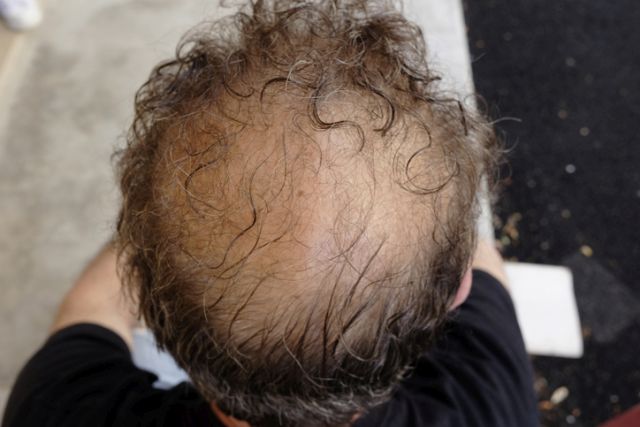Health
Understanding Telogen Effluvium
Published
5 years agoon
By
Farhan Malik
What is telogen effluvium?
Telogen effluvium is a type of hair loss that typically occurs after a period of intense stress or other shock to the system. The hair loss that occurs with telogen effluvium is usually on the top of the scalp.
The cycle of hair growth typically has three phases:
- Anagen or growth phase, when individual hairs are actively growing and lengthening.
- Catagen or transitional phase, when growth slows and stops but the hair shaft is still attached.
- Telogen or resting phase, when the hair shaft detaches, and hair shedding takes place to make room for new growth.
With telogen effluvium, an abnormally large amount of the hair is in the telogen phase. Under normal circumstances and absent unusual stress, 5 to 10 percent of a person’s hair is in the telogen phase at any one time. With telogen effluvium, the anagen, or growth, phase slows down, meaning that fewer hairs enter the next two stages. As a result, about 30 percent of hair follicles move into the telogen phase, and above average hair loss occurs.
What causes telogen effluvium?
Telogen effluvium is directly related to stress, trauma, or another shock to the system. Unlike many types of hair loss, telogen effluvium is not permanent, and the hair shedding typically occurs about 3 months after a stressful event. As I write this, we are in the middle of an economic shutdown and pandemic precautions, so it is to be expected that in about three months there will be a larger than normal amount of hair shed. This is a normal and expected response to the current stressors.
There are various other causes, including a poor diet. A shortage of dietary protein, iron, B-vitamins, and zinc may affect the quality of hair and its growth patterns. Sudden weight loss, whether intentional or unintentional, may cause hair to shed due to the stress placed on the body by a large change in weight.
Pregnancy triggers a prolonged growth phase, or anagen phase. This reverses at 3 to 6 months post-partum, causing the common phenomenon of post-pregnancy hair loss, or post-partum telogen effluvium. This is a normal response to all the hormonal changes of pregnancy and post-partum and will eventually result in many very short hairs as those follicles return to the growth phase.
Similarly, menopause and the accompanying hormone changes may also cause telogen effluvium.
Certain prescription and recreational drugs may cause hair loss. If you suspect this, talk to your doctor about the hair loss, and consider alternative treatment options or treatment for the recreational drug use.
Because surgery is usually a shock to the system, post-surgical telogen effluvium may occur. The incidence is affected by the type of procedure, length of stay in hospital, medications, and overall nutritional status.
An interesting side note: change in hair growth is often mirrored in nail growth. In the nails, this may show up as a groove across the nails at the time of the shock to the system, known as a Beau line. The time of the shock can be estimated by knowing that a fingernail takes approximately 5 months to grow from the posterior nail fold to the free edge.
Isn’t this the same as androgenic alopecia/male pattern baldness?
Telogen effluvium is not the same as androgenic alopecia/male pattern hair loss. However, distinguishing between the two can be difficult, especially considering that these conditions are not mutually exclusive. In general, if you are shedding clumps of longer hairs, this is telogen effluvium, where mature hairs are being shed as they enter the telogen phase. If you are shedding small amounts of short hair, this is likely to be androgenic alopecia, where hair is being lost prematurely.
Remember that it is possible to have both conditions occurring at the same point in time. See a dermatologist for a definitive diagnosis.
How do I treat telogen effluvium?
For simple, uncomplicated telogen effluvium, time and stress management are the best treatment options. Telogen effluvium is usually self-limiting and will reverse on its own in three to six months.
If there are other causes, look at addressing nutritional deficiencies through diet. Non-surgical hair replacement may be another option to consider. For people experiencing menopause-related hair loss, hormone replacement therapy may help.
Stress remains the primary cause of telogen effluvium, so stress management is the primary and most recommended treatment option. Counselling and stress management therapy should be considered as first-line treatment, unless there is a known medical condition or other symptoms of an underlying medical condition.
Avoid chemical or heat treatments that could damage the hair. Use high quality hair care products. Handle your hair gently and avoid over-brushing.
Another recommended option? Using a serum on a daily basis to help prevent hair loss caused by hormones, reduce hair breakage and contains ingredients studies show can dramatically trigger new ad thicker hair growth. Our top recommendation?
Hair Restoration Laboratories’ Maximum Hair Thickening Serum! This Serum is a powerful leave-in treatment, packed with clinically-studied ingredients to immediately provide maximum thickness to existing hair, minimize hair loss and maintain the scalp and hair follicles in optimum condition to promote the growth of thicker and stronger hair and reduce hair loss. The Serum contains Hair Restoration Laboratories’ proprietary DHT Halting Technology® with ingredients like green tea extract, saw palmetto extract, azelaic acid, pumpkin seed oil, black cumin seed oil, caffeine, biotin, cayenne fruit extract and ginseng that work synergistically to stop hair loss and help regrow and thicken hair.
The Serum also contains hair strengthening, building and anchoring ingredients, such as keratin, hydrolyzed collagen and caprylic triglyceride to dramatically maximize the thick appearance of your hair from the very first application. Ingredients, such as vitamin C, vitamin E, sunflower seed oil, argan oil and jojoba seed oil provide intense nourishment to your hair, noticeably improving the strength, natural shine and vibrancy.
Also, include protein-rich foods such as meat, eggs, fish, beans, grains, and nuts in your diet. Address possible iron deficiencies by eating lots of dark green leafy vegetables, liver, red meat, beans, and lentils.
If the issue continues for more than 6 months, see a physician to correct any abnormality in thyroid function, or levels of iron, vitamin B12 and folic acid.
You may like

Is Fmovies Safe? What You Need to Know Before Streaming

Dominating the Digital Pitch: A Step-by-Step Guide to Creating Futbol Libre Content

Conquering CricHD: A Comprehensive Guide to Cricket Streaming

What You Need to Know About Police Brutality?

12 Sites to Watch Free Online TV Shows with Complete Episodes in 2024


